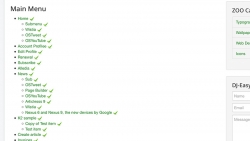Displaying items by tag: seo
 Even though the Joomla installation comes with an option to install sample content, I've never used it in a real site.
Even though the Joomla installation comes with an option to install sample content, I've never used it in a real site.
I think I installed the sample data the first time I installed a test version of Joomla, but I've never done it again.
In this post, I'll look at the Joomla sample content, and see if it's bad for SEO (Search Engine Optimization) to use this content on your site.
 I know many of you out there struggle with this one. When using the SEF extension sh404SEF, it's quite easy to set up search engine friendly URLs. For the core joomla components and supported third-party extensions, that is.
I know many of you out there struggle with this one. When using the SEF extension sh404SEF, it's quite easy to set up search engine friendly URLs. For the core joomla components and supported third-party extensions, that is.
If your extension does not have a plug-in for sh404SEF, you're basically stuck. Unless you apply some sort of work-around. In this case, I will show you how to create SEF URLs that show forms created by ChronoForms. It's easier than you would think.
This is the first part of a series of blog posts exploring Joomla meta tags.
In this first post I'll look at what meta tags are and what they should be used for.
The other posts in the series examine how to set up the meta tags by using the Joomla core, and with third-party SEF extensions. As well as setting up Google Webmaster tools.
 I was very happy to read todays update from Yannick Gaultier about the future of sh404SEF.
I was very happy to read todays update from Yannick Gaultier about the future of sh404SEF.
It seems he's talking with a "well established Joomla company" and I hope we'll see the continuation of sh404SEF in this company. With Yannick on board as the main developer. That's great news, Yannick - and for the rest of the Joomla community it's pure bliss :)
OK, so you have a brand new site going on - and it's all made in Joomla. But how to get traffic from the search engines?
There are several things you can do to ensure that Google and other search engines are picking up your pages. This will, over time, give you search engine positions for your keywords.
Without indexation, no positions, and no traffic from search engines. It's not rocket science, but you need to make sure that your pages are reachable by search engine spiders to get indexed.
I'll show you six steps to get your site indexed by Google and other search engines.
As a SEO aware web developer, you should learn about canonical links and how to use them in Joomla.
Canonical links are tags you enter into your page to ensure that Google indexes the correct page, and to avoid duplicate entries in the Google index.
Remember to always use the hyphen character (-) in your aliases. That way, you'll get more value from your URL keywords. Google treats hyphen (-) like a space, while it treats underscore as a non-breaking space.
![]() When you install Joomla 1.5 or later, the default title for the home page is «Welcome to the Frontpage».
When you install Joomla 1.5 or later, the default title for the home page is «Welcome to the Frontpage».
Many Joomla newbies have trouble changing this text. In fact, one of the most commonly asked questions for new Joomla users is 'Where is the "Welcome to the Frontpage" text?'.
Relax, I'll show you how to change it and make your site title into something relevant for your site.
There are basically three ways of approaching search engine friendly (SEF) URLs in Joomla. Here, I explain these three methods of Joomla SEO and their pros and cons.
Search engine friendly URLs are very important if you want to achieve good positions in Google and other search engines. Firstly, the URLs are a lot easier to understand for the user (more likely to be clicked). Secondly, and most importantly, they will (if well-built) contain keywords that the search engine may use in the indexation of the page and thus improve your rankings for those words.
The addition of Search Friendly (SEF) URLs will add greatly to your site in terms of search engine visibility.
In this tutorial, I show you how to set up one of the most popular SEF extensions for Joomla - sh404SEF.
My favorite SEF extension for Joomla is sh404SEF. I have tried a few other extensions as well, but sh404SEF is the one I'm comfortable with and which best seems to meet my requirements. This tutorial will help you duplicate the setup I use here at Joomlablogger.net.


